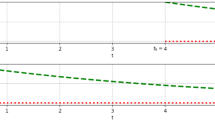Abstract
We consider a neoclassical (economic) growth model. A nonlinear Ramsey equation, modeling capital dynamics, in the case of Cobb-Douglas production function is reduced to the linear differential equation via a Bernoulli substitution. This considerably facilitates the search for a solution to the optimal growth problem with logarithmic preferences. The study deals with solving the corresponding infinite horizon optimal control problem. We consider a vector field of the Hamiltonian system in the Pontryagin maximum principle, taking into account control constraints. We prove the existence of two alternative steady states, depending on the constraints. A proposed algorithm for constructing growth trajectories combines methods of open-loop control and closed-loop regulatory control. For some levels of constraints and initial conditions, a closed-form solution is obtained. We also demonstrate the impact of technological change on the economic equilibrium dynamics. Results are supported by computer calculations.
Similar content being viewed by others
References
F. P. Ramsey, “A mathematical theory of saving,” Econ. J. 38 (152), 543–559 (1928).
D. Acemoglu, Introduction to Modern Economic Growth (Princeton Univ. Press, Princeton, 2008).
D. Romer, Advanced Macroeconomics (McGraw-Hill, New York, 2011; Vysshaya Shkola Ekonomiki, Moscow, 2014).
N. N. Moiseev, “Theory of optimal control in an infinite time interval,” USSR Comput. Math. Math. Phys. 14 (4), 33–43 (1974).
L. S. Pontryagin, V. G. Boltyanskii, R. V. Gamkrelidze, and E. F. Mishchenko, The Mathematical Theory of Optimal Processes, 2nd ed. (Nauka, Moscow, 1969; Gordon and Breach, New York, 1986).
S. M. Aseev, K. O. Besov, and A. V. Kryazhimskii, “Infinite-horizon optimal control problems in economics,” Russ. Math. Surv. 67 (2), 195–253 (2012).
S. M. Aseev and A. V. Kryazhimskii, “The Pontryagin maximum principle and optimal economic growth problems,” Proc. Steklov Inst. Math. 257, 1–255 (2007).
I. G. Malkin, Theory of Motion Stability, 2nd ed. (Nauka, Moscow, 1966) [in Russian].
V. I. Maksimov and Yu. S. Osipov, “Infinite-horizon boundary control of distributed systems,” Comput. Math. Math. Phys. 56 (1), 14–25 (2016).
D. Grass, J. P. Caulkins, G. Feichtinger, G. Tragler, and D. A. Behrens, Optimal Control of Nonlinear Processes (Springer, Berlin, 2008).
R. M. Solow, “Technical change and the aggregate production function,” Rev. Econ. Stat. 39 (3), 312–320 (1957).
W. T. Smith, “A closed form solution to the Ramsey model,” BE J. Macroecon. 6 (1), 1–27 (2006).
K. Shell, “Applications of Pontryagin’s maximum principle to economics,” Mathematical Systems: Theory and Economics, Ed. by H. W. Kuhn and G. P. Szego (Springer, Berlin, 1969).
A. A. Krasovskii and A. M. Tarasyev, “Properties of Hamiltonian systems in the Pontryagin maximum principle for economic growth problems,” Proc. Steklov Inst. Math. 262, 121–138 (2008).
R. L. Keeney and H. Raiffa, Decisions with Multiple Objectives: Preferences and Value Tradeoffs (Wiley, New York, 1976; Radio i Svyaz’, Moscow, 1981).
A. A. Krasovskii and A. M. Tarasyev, “Dynamic optimization of investments in the economic growth models,” Autom. Remote Control 68 (10), 1765–1777 (2007).
A. A. Krasovskii and A. M. Tarasyev, “Construction of nonlinear regulators in economic growth models,” Proc. Steklov Inst. Math. 268, Suppl. 1, 143–154 (2010).
P. Hartman, Ordinary Differential Equations (Wiley, New York, 1964; Mir, Moscow, 1970).
A. A. Krasovskii, A. M. Tarasyev, and C. Watanabe, “Optimization of functionality development,” Appl. Math. Comput. 217 (3), 1125–1134 (2010).
P. D. Lebedev and A. A. Uspenskii, “Procedures for calculating the nonconvexity measures of a plane set,” Comput. Math. Math. Phys. 49 (3), 418–427 (2009).
Author information
Authors and Affiliations
Corresponding author
Additional information
Published in Russian in Zhurnal Vychislitel’noi Matematiki i Matematicheskoi Fiziki, 2017, Vol. 57, No. 5, pp. 768–782.
Rights and permissions
About this article
Cite this article
Krasovskii, A.A., Lebedev, P.D. & Tarasyev, A.M. Bernoulli substitution in the Ramsey model: Optimal trajectories under control constraints. Comput. Math. and Math. Phys. 57, 770–783 (2017). https://doi.org/10.1134/S0965542517050050
Received:
Published:
Issue Date:
DOI: https://doi.org/10.1134/S0965542517050050



